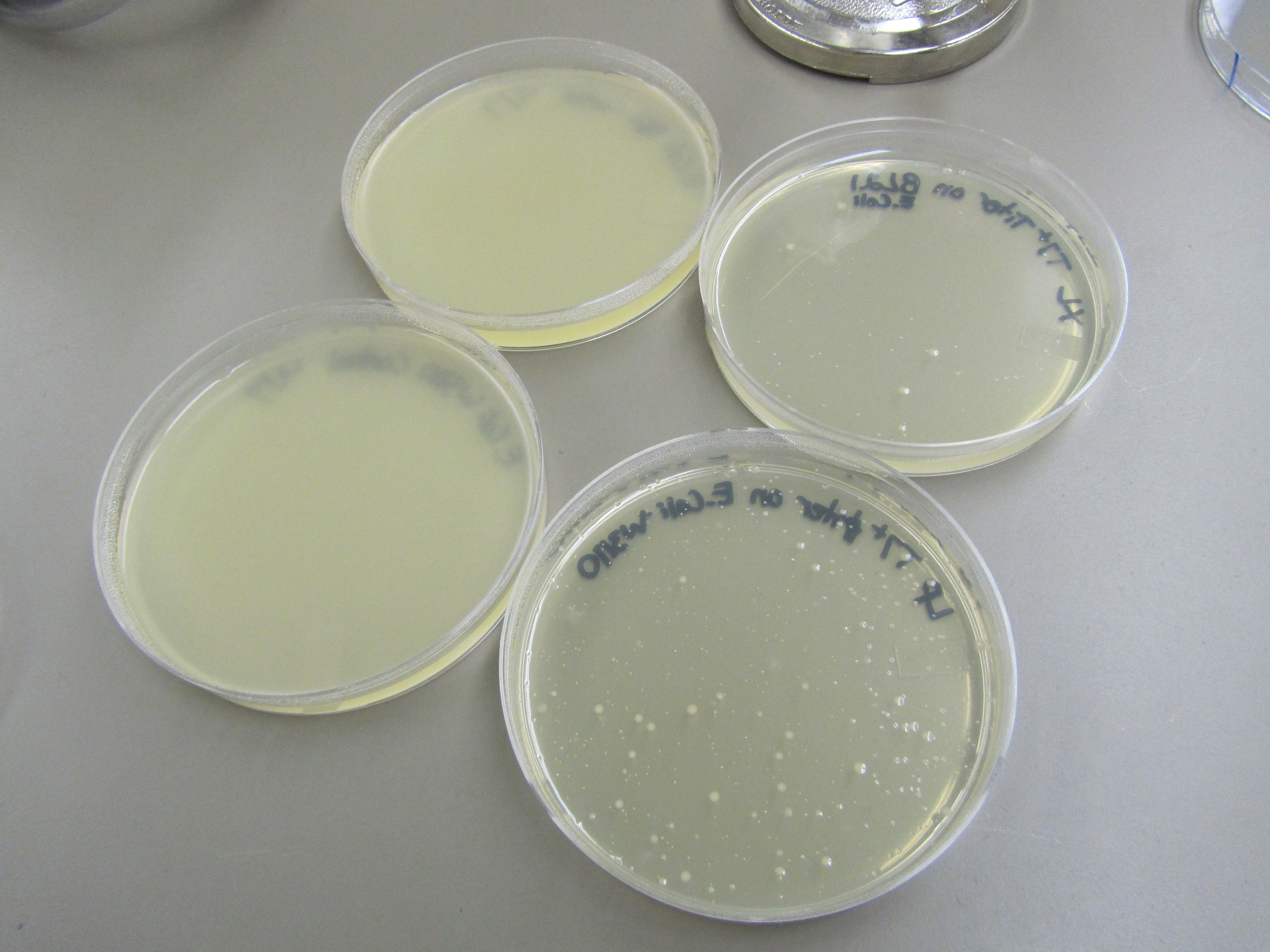|
4.8 T7 Phage Viability Test 2
I) Purpose
- Test the viability (concentration if possible) of the T7 we got
- Become familiar with virus titering techniques
- Identifying T7 mutant and T7 WT
II) Expected outcome
- Should see multiple plaques forming on a lawn of E coli (confluent growth)
- T7 WT should grow, even though T7 mutant didn’t (4.5 phage viability assay)
III) Reagent record
T7 phage *; E coli BL21; Agar: ×2 prepared by Jordan in 500mL glass bottle; LB: prepared by Jordan in big Erlenmeyer flask; overnight bacteria culture: set up on Sat 3/6 at 6pm
IV) Actual procedures / observations
1) Dilution series of bacteriophage and its incubation with E coli
- i) 90μL of LB broth were added to added to each dilution vial, labeled 1-5.
- ii) 10μL stock phage solution (T7*) was added to vial 1.
- iii) Perform a serial dilution (1:10) with vial 1-5, decreasing phage concentration to 10% of the previous vial with each.
2) Perform spot test
- i) In 50mL plastic centrifuge tube, combine 2mL of E. coli BL21 overnight liquid culture, 10mL of warm ×2 top agar, and 10mL LB.
- ii) In another 50mL plastic centrifuge tube, combine 2mL of E. coli W3110 overnight liquid culture, 10mL of warm ×2 top agar, and 10mL LB.
- iii) 5mL of the combined solution were added to each LB plate. Wait for top agar (containing E. coli BL21 and W3110 individually) to solidify before proceeding to spot test.
- iv) Divide each plate into 6 sections, labeled 0-5. Spot 5μL of liquid from each vial onto different sections of the plate. Vial and section should correspond in number. On section 0, 5μL taken from phage liquid stock where spotted directly (performed for both BL21 and W3110 individually).
- v) Set up one E coli control plate by taking 5mL of the combined solution from the centrifuge tube (2-i step) and plated it on an LB plate (performed for both BL21 and W3110 individually).
30 Phage plaque size test
- i) BL21 test tube: add 20 μL of stock phage solution, 0.5mL E coli BL21 overnight liquid culture
- ii) W3110: add 20 μL of stock phage solution, 1mL E coli W3110 overnight liquid culture
- iii) Let both test tube sit for 20min
- iv)In a 50mL centrifuge tube, combine 6mL of warm ×2 top agar and 6mL of LB to produce ×1 top agar
- v) Add 5mL of ×1 top agar to each test tube, pipet up and down several times before plating 5mL unto LB plates
4) Check up on phage + bacteria viability in 24 hours.
IV) Results
1) Plates
Spot Test Plates
| Label
| Plate
| Results
|
| Control E coli BL21
| Step 2 v
| Uniform lawn of E coli, no infection
|
| Control E coli W3110
| Step 2 v
| Uniform lawn of E coli, no infection
|
| XL spot test E coli BL21
| Step 2 iv
| Circular lyse area at all 6 spots, decreasing in size
|
| XL spot test E coli W3110
| Step 2 iv
| Circular lyse area at all 6 spots, decreasing in size
|
| LJ spot test E coli BL21
| Step 2 iv
| Formed circular lyses in all 6 spots that decreased in size from spots 0 to 5
|
| LJ spot test E coli W3110
| Step 2 iv
| Formed circular lyses in all 6 spots that decreased in size from spots 0 to 5
|
| 20μL phage + 0.5mL of E coli BL21
| Step 3
| Nearly complete clearance
|
| 20μL phage + 0.5mL of E coli W3110
| Step 3
| Nearly complete clearance
|
2) Spot test compared to control (top: BL21; bottom: W3110)
Circular plaques formed for each spot test. The plaques decreased in size as phage in LB becomes more diluted. No contamination seen.
3) Titer test compared to control (top: BL21; bottom: W3110)
Phage is clearing up the entire plate. This indicates that the phage we used are at too high of a concentration.
V) Conclusions
- T7* is the WT T7 phage. It is able to grow on E coli BL21.
- Our stock phage liquid culture is at too high concentration to form a few individual plaques on a plate. It’s clearing up the entire area.
VI) Proposed next step
1) Perform the same spot test with more diluted T7 solution. Look for where the plaques are barely forming.
|  "
"

